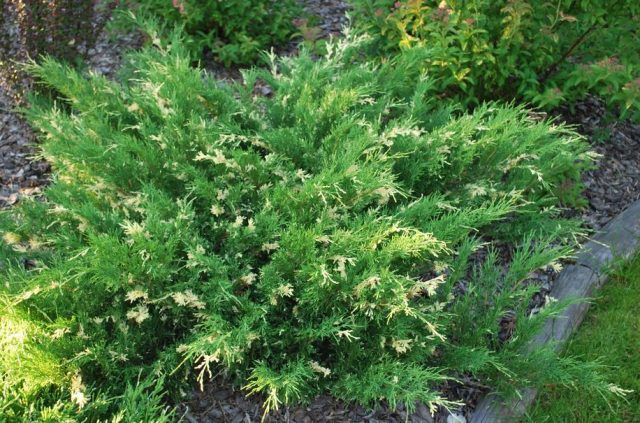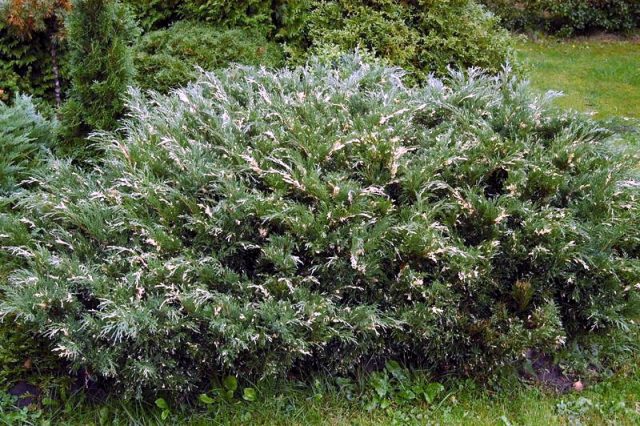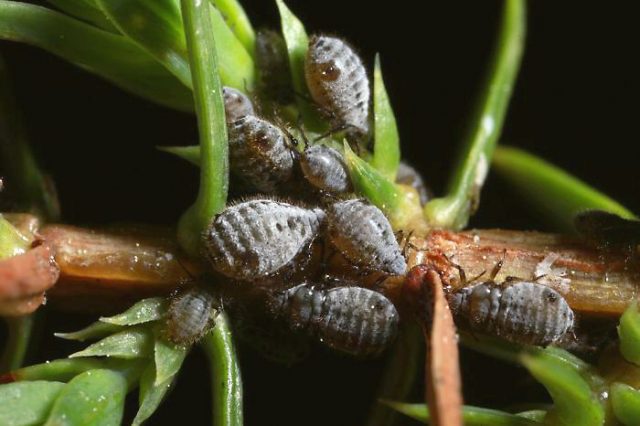Content
Juniper horizontal Andorra Variegata belongs to coniferous shrubs of low growth and moderate branching. A distinctive feature of this variety is the cream color of the growing cone of each young branch, which is different from the main color of the needles. The plant is very decorative and is used in landscape design.
Description of Andorra Variegata juniper
At a young age, Andorra Variegata is a relatively small compact bush with a very dense crown. Bushes of a more respectable age grow significantly in breadth and resemble creeping varieties of juniper (for example, Cossack juniper). They can reach a very large diameter, more than 2 m, but in any case, the height of the Andorra Variegata juniper does not exceed 35-50 cm.
The location of the shoots in the bush is radiant. They always grow upward (rarely at an angle exceeding 45 °), but very quickly the direction of growth of young branches changes, and they go into a horizontal plane. The needles of the bushes are short and thin, they are quite tightly pressed against the shoots. The texture of the needles is scaly, pronounced. The color of the needles in summer for this variety, which is in the sun, is ash green, and for those that grow in the shade or partial shade, it is emerald green.
At the end of October, with the arrival of the first frost, the needles change their color to purple-violet. In the spring, when new shoots start to grow, the color changes again. The growing cone of each branch has a creamy color with a yellow or whitish tint for almost the entire season. This is a characteristic feature of this variety.
The fruits of Andorra Variegat are small, inconspicuous. Unlike most junipers, which have a contrasting blue color of the fruit, the whitish fruits of the Andorra Variegata juniper are almost invisible against the background of its branches.
The annual growth of the length of shoots rarely exceeds 10 cm. However, due to the large number of annually formed shoots, it covers the entire surface of the soil with its vegetation, where the tips of its branches reach.
Juniper horizontal Andorra Variegata is shown in the following photo. The color of the bush corresponds to the summer period.
Although Andorra is a light-loving shrub, it perfectly tolerates partial shade. At the same time, the growth rates decrease slightly.
Juniper Andorra in landscape design
The creeping juniper Andorra Variegata stands out favorably against the background of dark or grayish shades of the "background" of rock gardens - mulch from bark or pebble mound. That is why designers like it so much. In addition, the neutral ash green or emerald green colors of this variety can be perfectly combined with almost any conifers on the alpine slides.
A shrub can be a wonderful decoration not only for a rock garden, but also for a rocky garden, meadow, forest edge, roadside or coastal zone.Separately, it should be noted that the tips of the shoots of the bush give it a very elegant look, which can also be played up in the design by combining with cream or white shades of flowers in flower beds.
One of the advantages of the shrub is the possibility of its use in design without the need for stationary planting - the horizontal Andorra Variegata juniper can perfectly fulfill its decorative functions, being in a pot or container.
The excellent "performance" qualities of this variety of juniper are also highly valued by designers. Endurance and unpretentiousness allow this juniper to be placed on almost any soil and conditions that are most unsuitable for the growth of other plants.
Planting and caring for horizontal junipers Andorra
Juniper planting is carried out in mid-spring or early autumn. Usually, there is no preliminary preparation, except for digging a hole for the plant. Caring for the horizontal juniper Andorra Variegata is quite simple and does not require much time or particularly complicated procedures from the gardener.
Seedling and planting plot preparation
Despite the fact that Andorra Variegata horizontal juniper can grow in almost any light, the plant prefers sunny areas with low acidity soil. The optimal soil for it will be fertile, moisture-permeable loams. If there is no suitable soil nearby, you can make it yourself. The composition of the soil mixture includes the following components:
- peat - 2 parts;
- sand - 1 part;
- sod land - 1 part.
The hole for the bush should be about twice as large as the earthen lump of the seedling. There is no treatment of the seedling, except for the sanitary pruning of diseased and damaged branches.
Andorra juniper planting rules
Planting is carried out according to the scheme 2x2 m. The pits for adult specimens should have a depth of at least 70 cm, for young ones - the size of an earthen coma. A drainage layer of broken brick or crushed stone is laid at the bottom of the pit. The thickness of the drainage layer is at least 15 cm.
The plant is set in a pit, leveled and covered with earth, after which the surface is carefully tamped.
During the week after planting, the plant needs abundant watering.
Watering and feeding
Watering a rooted bush is carried out no more than 1 time in 2-3 weeks. At the same time, it is recommended to apply sprinkling at each watering, because, despite its good drought resistance, the horizontal juniper Andorra Variegata does not like dry air.
Top dressing is applied twice a year:
- mineral nitrogen or complex (for example, nitroammofoska) - late April or early May;
- organic (mulching with a layer of peat 10 cm) - just before the beginning of winter.
Mulching and loosening
Within 1-2 years after planting young plants, the soil under them should be loosened with each watering to a depth of 3-5 cm. An adult plant does not need to be loosened, since almost always the soil under it is mulched with the bark of coniferous trees or spruce branches. The mulch layer can be changed once a year. This is usually done in early spring.
Trimming and shaping
According to the description, Andorra Variegata horizontal juniper has a crown, the shape of which does not change over time. In addition, it has a low growth rate, and no formative pruning is provided for it.
If it becomes necessary to change the shape of the bush to please the owner's design whims, then this can be done at any time of the year, but it is best to form the bush in the spring.
Preparing for winter
The bush does not need any specific preparation for winter, since it has the winter hardiness of the third zone, that is, it can withstand frosts down to -40 ° C.In those cases, when there is a desire to hedge and protect the plants from frost, it is recommended to cover the Andorra Variegata juniper bushes with a layer of polyethylene. A layer of fallen leaves 20-30 cm high is laid on top of it.
Reproduction of Andorra juniper
The reproduction process of the Andorra Variegata juniper is carried out using the seed method or by cuttings. It is believed that obtaining semi-lignified cuttings with their subsequent germination is the most optimal way of dividing this juniper subspecies. If seeds are used for this purpose, then there is a high probability of losing the characteristic exterior qualities of this variety.
Diseases and pests of AndorraVariegata juniper
The main diseases of the horizontal Andorra Variegata juniper are rust and drying out of branches. Both are caused by fungi (sporangium and cytospores) that live primarily on conifers and pink plants.
Rust is practically incurable, although the symptoms can be significantly reduced with the help of fungicidal preparations, and drying out can be dealt with with the usual spraying with copper sulfate at a concentration of 1%. In this case, damaged branches should be removed by treating the places of their cut with drying oil and garden varnish. The main form of preventing plants from diseases is planting them from each other, as well as from representatives of the Pink family at long distances.
The main pests of juniper are the juniper aphid and the juniper scale insect. They are helped by drugs related to systemic insecticides - Confidor, Calypso or Mospilan. Usually, there are no preventive measures for pest control, insecticides are used only upon their appearance.
Conclusion
Juniper horizontal Andorra Variegata is a plant of short stature, which is widely used in the design of gardens, parks, alpine slides and rockeries. The plant is a typical juniper and has all the pros and cons of this species. The peculiarities of Andorra Variegata are exclusively external, consisting in a special crown shape (up to half a meter high and no more than 2 m in diameter) and the creamy color of the tops of the shoots, which give the plant an extremely elegant look.
Reviews of juniper horizontal Andorra Variegata

















